Events
Cultural Event
03/06/2012
- 03/06/2012
New York (NY)
Overcoming the Disaster: Gratitude from Japan to the World
March 6, 2012 at 7:30 PM
Rose Theater, Frederick P. Rose Hall,
home of Jazz at Lincoln Center on Broadway at 60th Street.
This concert is free but tickets are required.
On the first anniversary of the Japanese Earthquake and Tsunami, a worldwide series of free
concerts has been dispatched to convey the Japanese people’s sincere gratitude to the global community
for its tremendous outpouring of support. On Tuesday, March 6 at 7:30 PM,
The Japan Foundation will present “Overcoming the Disaster: Gratitude from Japan to the World,” at Rose Theater, Frederick P. Rose Hall, home of Jazz at Lincoln Center on Broadway at 60th Street New York City. The event features noted musicians from Japan of various genres, including artists from Tōhoku, the region most greatly impacted by the disaster.
The Japan Foundation is the organizer of this New York concert and the entire worldwide tour. The aim of the concerts is to show that Japan is steadily heading towards recovery with a new “Kizuna” – bonds of friendship – with the international community. The Japan Foundation writes, “We would like to express our sincere gratitude to the global community for their tremendous support….Through this project, we wish to convey a message from the citizens in the affected areas to the international community about how important and encouraging it is for those in difficulty to receive signs of solidarity from the unknown global community. At the same time we wish to show that we also stand by many other disaster victims and refugees around the world, thus sharing a heartfelt prayer for peace among all peoples.”
The evening will begin with a prayer for disaster victims anywhere. Nine troupes, involving 30 musicians, will be presented. Headliners will include Ondekoza, seven players of enormous taiko drums whose performance is a fusion of dance and drumming. This performance will also include New York children playing bamboo instruments that will be fashioned in a workshop led by musicians of Ondekoza on Sunday, March 4 at Avenue C Studios on the Lower East Side.
Also headlining will be Wakumizu Kagura, a folk performing arts group from the area stricken by the earthquake and tsunami. Kagura is a Shinto musical dance,from ancient Japan thought to be pleasing to the gods. Twelve performers will appear.
The evening will also include Kazutoki Umezu with brass quartet Umezu Chibi Brass; Ochi Brothers (percussion duo), Sizzle Ohtaka (vocals), Suguru Ikeda (vocals & Iriomote sanshin, a stringed instrument), Yoichi Nozaki (electric piano), Yumiko Tanaka (traditional shamisen and vocals), and Bamboo Orchestra featuring Kimihiro Kitamura.
The commemoration project will be performed March 2 at The Ahmanson Theatre, LA Music Center and will tour to France March 10-11 and China March 14 to 26. The musicians are also performing at United Nations Headquarters. (Invitation only)
Video clips of selected artists are available at: http://www.youtube.com/watch?v=WNN9dOsWUBs. The clips include performances by Ondekoza (Taiko Drums) and Wakumizu Kagura ( Tōhoku Folklore Group).
The concert has been curated and directed by Mitsuo Tamura. Production Manager is GOH Productions, NYC.
On Sunday, March 4 from 2:00 PM to 5:00 PM, musicians from Ondekoza and interpreters will lead up to 30 lower and middle-income students from the Lower East Side, ages 7-15, in a free bamboo instrument making workshop at Avenue C Studios, 55 Ave. C (near E. 4th Street). News and TV coverage are invited. The kids, mostly students of East Village Dance Project, will perform on these instruments as part of Ondekoza’s performance at Jazz at Lincoln Center on March 6.
The Japan Foundation is the first organization to specialize in international cultural exchange in Japan. Its purpose is to contribute to the improvement of a positive international environment and to the maintenance and development of harmonious foreign relationships with Japan. Through efficient and comprehensive implementation of activities and international cultural exchange to deepen other nations’ understanding of Japan, the Japan Foundation hopes to promote better mutual understanding among nations.
The performance is supported by the Consulate General of Japan in New York.
read an article in the New York Times
ABOUT THE ARTISTS
This wide-ranging collective of musical groups and individual artists displays a unique combination of music and rhythms. Under the theme ‘harmony with nature,’ which is the most important element of Japanese culture, the artists play various traditional Japanese instruments such as taiko drums, shamisen, bamboo instruments and contemporary Western instruments. To-date, their performances and educational workshops commemorating the Great East Japan Earthquake and Tsunami of 2011 have been presented in Korea, South Africa, Saudi Arabia, Czech Republic, Germany and more.
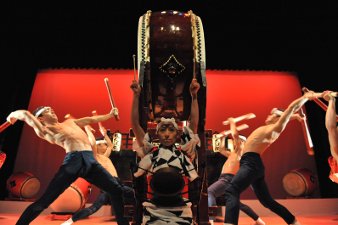 Ondekoza
Ondekoza
Formed in 1969 under the direction of Den Tagayasu, Ondekoza is widely recognized as one of groups to have set the groundwork for taiko as a performance art. The group was originally created on the Japanese island of Sado, where a group of young men and women gathered to follow the ideals of Den Tagayasu, notably that “running is one with music, and both reflect the energy and drama of life.” Using their retreat center at the foot of Mount Fuji in Shizuoka prefecture, they begin their training by running 10 kilometers every morning at 6:00 AM.
In 1975, Ondekoza made its dramatic international debut in Boston, where upon completing the Boston Marathon, members immediately ran onto stage to perform on their 350kg ‘Odaiko’ drum. The group marked its 40th Anniversary in 2008 with the beginning of the “Kikon-Ichida” Live Tour which started with a show at National Theater of Japan and continued to the U.S., China, Taiwan, Croatia, Italy, Switzerland, and Germany.
Ondekoza also joins forces with internationally acclaimed musicians to form a unique ever-evolving musical experience in which they create instruments and lead performance workshops with local children and residents, culminating in an all-participant concert. The group has performed in collaboration with people all over the Japan and the world, working with each region’s people, landscapes, culture and history through musical exchange.
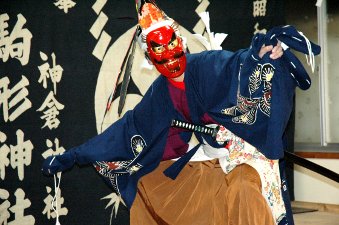 Wakumizu Kagura
Wakumizu Kagura
Kagura is an ancient traditional Japanese art form composed of music and dance, performed to honor deities. Wakumizu Kagura was founded in 1932 by a regional farming community in Iwate prefecture in the Tohoku region in northeastern Japan. Its style incorporates Hayachine Kagura, which is inscribed in the UNESCO Intangible Cultural Heritage List and involves a masked dancer accompanied by taiko drum, gong and flute. To this day, residents gather in shrines to watch and perform these musical dances to pray for safety, an abundant harvest or good health on New Years or following the harvest.
In the Tohoku region, a harsh environment where people have survived famines and natural disasters throughout history, folk performances are said to function as a requiem of the souls who have passed. Many artifacts of folk traditions in the region were devastated by last year’s earthquake and tsunami. Nevertheless, residents have already resumed presenting a few performances with the intention of soothing the souls of those who were lost in the disasters. These performances lie at the heart of people’s identities and are a connection to home for those who had to evacuate to places far from their home towns.
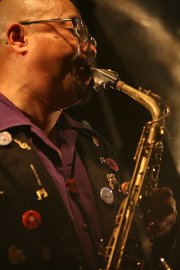 Kazutoki Umezu
Kazutoki Umezu
Born in Miyagi prefecture, Kazutoki Umezu was active in the loft jazz scene in New York in the early 1970s before returning to Japan and joining the free jazz ensemble Seikatsu Kojoiinkai Daikangen Gakudan. Since then, he has performed with countless musicians both within and outside Japan, cultivating a unique sound and stage presence. Beyond performance jazz, he also works steadily in film, radio, music, essay writing and commercial voiceovers. He has a strong personality onstage coupled with a vibrant sound and sense of humor and soul resembling the blues or Japanese ENKA. For this project, Umezu will perform with his new brass quartet, Umezu Chibi Brass, comprised of Kazutoki Umezu (alto sax), Yoko Tada (tenor sax), Tomoyuki Mihara (trombone) and Naoki Hishinuma (tuba).
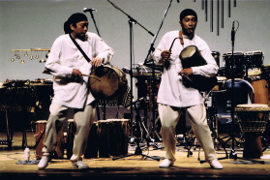 Ochi Brothers
Ochi Brothers
Ochi Brothers are the percussion duo of Yoshiaki and Yoshihisa Ochi, who combine traditional folk instruments from Asia and Africa. They frequently work with natural percussive sounds using water, wood, bamboo, and stone as musical instruments. They performed at New York’s LaMaMa Experimental Theater in 1993 and 1997 to great acclaim. The group’s varied activities include composing music for TV, radio, stage, dance, and fashion shows to environmental soundscapes, musical production, and leading sound and rhythm workshops for both children and adults.
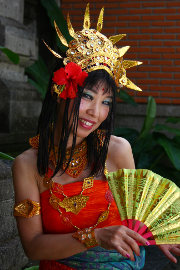 Sizzle Ohtaka
Sizzle Ohtaka
Rainbow-voiced Sizzle Ohtaka uses her extraordinary, flexible, and unique voice as an instrument to create music which cannot be simply classified as traditional, new age, world music or experimental. She calls her original vocal style “Rainbow Voice” and has sung and performed in hundreds of radio and TV commercials. In 2003, she created Futon Logic, an eclectic performance troupe, and performed at I.C.A. (Institute of Contemporary Arts) in London. Her recent works include the TV program “Nihongo de Asobo,” for which she produced the music and sang traditional children’s songs. She has released 21 albums, including collections of her best songs. In 1999, Hamza El Din collaborated with her for his album” A Wish,” which was released in USA. Other popular solo albums include “Furusato” and “Sugarland.” She has participated in the Edinburgh Fringe Festival, the Berlin Jazz Festival, the Kazakhstan Jazz Festival, and the Song Festival in Estonia and has been in this project since it began. She has collaborated with Yoshiko Chuma and The School of Hard Knocks on numerous projects around the world.
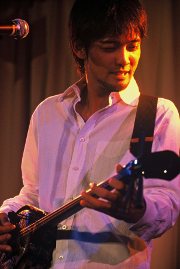 Suguru Ikeda
Suguru Ikeda
Suguru Ikeda is one of the most celebrated performers of Okinawan music in his generation, specializing in vocals and the sanshin lute. Born in 1979 in the tiny village of Funauki (population 42) on the Okinawan island of Iriomote, he was an avid baseball player while growing up and pitched for the Okinawa Suisan High School team. When he was 19, he participated in the island summer art festival, which began his professional career in music. Ikeda’s CD debut came in 2000 with the release of Shima no Hito Yo (Oh, Islanders), which drew attention as the background music for television weather reports. His national debut came in 2005 with the release of another CD, Kokoro Iro (Color of the Heart). To date, Ikeda has issued seven CDs, including a collection of Yaeyama folk songs. Many of his songs have been used in television commercials and are widely loved in his native Okinawa, where he is currently based. He is active as a performer throughout Japan and has branched out into other fields as a radio personality, lecturer, author and actor, playing the lead role in Endo no Hana (Flowers by the Wayside). As a popular singer, Ikeda has become an essential performer at music festivals, Okinawan music concerts and other events held both inside and outside of Okinawa.
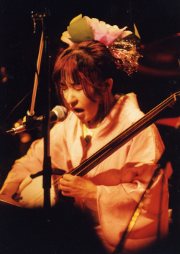 Yumiko Tanaka
Yumiko Tanaka
Yumiko Tanaka is a Japanese shamisen player and a singer. She studied and has been performing the traditional Gidayu music. Besides traditional music, she explores and collaborates in contemporary music, jazz, dance and theater. She worked with Yuji Takahashi, Otomo Yoshihide, Min-Xio Fen, Ned Rothenberg, Kiyohiko Semba, Uchihashi Kazuhisa, Elliott Sharp, David Moss, Carl Stone, Butch Morris, Heiner Goebbels, Basil Twist and among many others. Tanaka has a Master’s degree in musicology from Tokyo University of Fine Arts and Music. In 1991 she was awarded the Minister of Education’s Art Encouragement Prize for Newcomers for the year 1990. In 1999 she received the Committee’s Special Prize at the 68th Japan Music Competition. She is an associate professor at Hyogo University of Teacher Education. In 2006, she was awarded a fellowship by Asian Cultural Council (ACC) and stayed in NY for five months to research developments in contemporary performing arts in the US. In 2009 she was designated an Intangible Cultural Heritage as a member of the Gidayubushi Preservation Society.
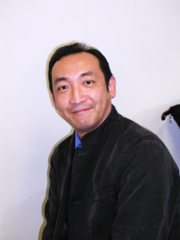 Bamboo Orchestra (Kimihiro Kitamura, instrument construction and performance)
Bamboo Orchestra (Kimihiro Kitamura, instrument construction and performance)
Formed in 1993 as Japan’s first ever bamboo instrument ensemble, this orchestra is composed of Japan’s traditional bamboo instruments shakuhachi, shinobue and sho, among other Asian instruments. Kitamura, who performs and creates many of the instruments, graduated from the Gagaku Faculty of the Music School at Tokyo University of the Arts. Since graduating from the Graduate School of Musical Studies at the same university, he has been active with the Bamboo Orchestra since its founding.
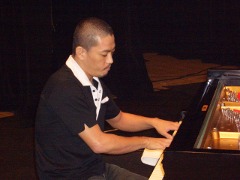 Yoichi Nozaki
Yoichi Nozaki
Yoichi Nozaki (Piano) was born in Tokyo in 1970. He began learning the piano since when he was a child, and made his professional debut at the age of 19 as a supporting member of Ryoji Kurihara’s band. Since then, he has performed many live concerts with a variety of artists including Takako Okamura, Hiroko Moriguchi, Kenji Sawada, Seiko Matsuda and Sojiro and Hiromitsu Agatsuma (shamisen).
Workshop
EMBRACING THEIR PLACE IN THE GLOBAL COMMUNITY WITH BAMBOO INSTRUMENTS
Kids made their own percussion and wind instruments, with which to jam with Japanese musicians in a Lincoln Center concert expressing Japan’s gratitude for the world’s support during its Earthquake and Tsunami.
by Jonathan Slaff
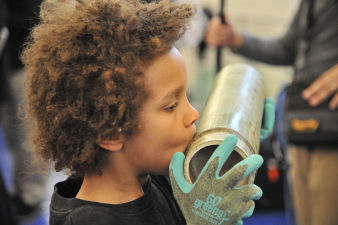 “Man, this is going to drive my mom crazy!,” exclaimed Safouane Chestnut, age 8, celebrating his new-found ability to make tones on the hora. Photo by Lee Wexler/Images for Innovation.
“We learn from the children,” declared Mitsuo Tamura, director of the concert, “Overcoming the Disaster: Gratitude from Japan to the World.” The event was about to be presented by The Japan Foundation at Frederick P. Rose Hall, home of Jazz at Lincoln Center on Tuesday, March 6. It is one of a worldwide series of free concerts that has been dispatched by the Japan Foundation to convey the Japanese people’s sincere gratitude to the global community for its tremendous outpouring of support during the Great Japanese Earthquake and Tsunami. Now it was March 4, the Sunday before the performance, and 13 children, ages six to 13, all from Manhattan’s Lower East Side, had joined musicians from the concert–all from Japan–at Avenue C Studios, 55 Ave. C (near E. 4th Street) for a Bamboo Instrument Making Workshop.
“Man, this is going to drive my mom crazy!,” exclaimed Safouane Chestnut, age 8, celebrating his new-found ability to make tones on the hora. Photo by Lee Wexler/Images for Innovation.
“We learn from the children,” declared Mitsuo Tamura, director of the concert, “Overcoming the Disaster: Gratitude from Japan to the World.” The event was about to be presented by The Japan Foundation at Frederick P. Rose Hall, home of Jazz at Lincoln Center on Tuesday, March 6. It is one of a worldwide series of free concerts that has been dispatched by the Japan Foundation to convey the Japanese people’s sincere gratitude to the global community for its tremendous outpouring of support during the Great Japanese Earthquake and Tsunami. Now it was March 4, the Sunday before the performance, and 13 children, ages six to 13, all from Manhattan’s Lower East Side, had joined musicians from the concert–all from Japan–at Avenue C Studios, 55 Ave. C (near E. 4th Street) for a Bamboo Instrument Making Workshop.
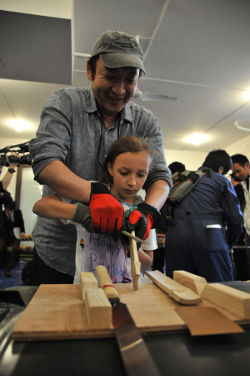 Kimihiro Kitamura guides Charley Forgeois (yes, her name’s Charley) in filing a take bera. Photo by Lee Wexler/Images for Innovation.
The job of the day was to fabricate the very instruments the kids would play in the actual concert Tuesday night at Lincoln Center. A spacious, white-walled dance studio in Manhattan’s East Village was set up with work tables, a gigantic bamboo marimba and a large taiko drum that would be played by Ondekoza, Japan’s premiere taiko orchestra. Musicians from Ondekoza were in attendance, as were other musicians from the concert: Umezu Chibi Brass (a quartet of two saxophones, trombone and tuba); Ochi Brothers (a percussion duo), Sizzle Ohtaka (a vocalist ), Suguru Ikeda (a stringed instrument player from Okinawa) and Kimihiro Kitamura (originator of “Bamboo Orchestra” and specialist in the fabrication of bamboo instruments). It was Kimihiro Kitamura, dressed in a denim shirt, who primarily instructed the kids, translated by Kanako Hiyama, who was born in Japan but now lives in Brooklyn.
Kimihiro Kitamura guides Charley Forgeois (yes, her name’s Charley) in filing a take bera. Photo by Lee Wexler/Images for Innovation.
The job of the day was to fabricate the very instruments the kids would play in the actual concert Tuesday night at Lincoln Center. A spacious, white-walled dance studio in Manhattan’s East Village was set up with work tables, a gigantic bamboo marimba and a large taiko drum that would be played by Ondekoza, Japan’s premiere taiko orchestra. Musicians from Ondekoza were in attendance, as were other musicians from the concert: Umezu Chibi Brass (a quartet of two saxophones, trombone and tuba); Ochi Brothers (a percussion duo), Sizzle Ohtaka (a vocalist ), Suguru Ikeda (a stringed instrument player from Okinawa) and Kimihiro Kitamura (originator of “Bamboo Orchestra” and specialist in the fabrication of bamboo instruments). It was Kimihiro Kitamura, dressed in a denim shirt, who primarily instructed the kids, translated by Kanako Hiyama, who was born in Japan but now lives in Brooklyn.
There were thirteen work stations laid out, each equipped with notched rails into which the bamboo stalks would fit for cutting and finishing. Bamboo from Japan had been flown in for the job, both green stalks, young and wide, and aged stalks, pre-cut into slats. Protective gloves were issued to prevent against splinters. Kids were coached in using the tools by the Japanese musicians, with a little help from their parents, who were encouraged to join in.
The kids had seen bamboo before (some said, in the zoo) but none could say they had touched it. They were surprised to learn about the bamboo’s life: it’s a grass, not a tree, and it can grow to about sixty feet high in about a month. Each piece of bamboo, it was explained, is an individual: its tone changes as it ages. The young musicians were to give voice to the bamboo.
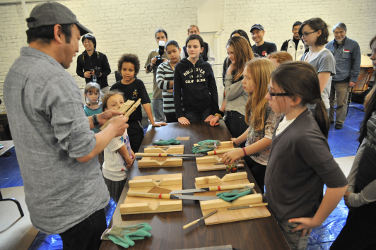 Kimihiro Kitamura guides the kids in making take bera, or musical sticks. Photo by Lee Wexler/Images for Innovation.
Their first job was to create take bera, or musical sticks. First, you had to pick out nearly matching sticks from a pre-cut supply. The better ones, Mr. Kitamura explained, have a wide section above the rib. You had to match them as well as you could, then cut them to equal lengths by trimming with a Japanese saw.
Kimihiro Kitamura guides the kids in making take bera, or musical sticks. Photo by Lee Wexler/Images for Innovation.
Their first job was to create take bera, or musical sticks. First, you had to pick out nearly matching sticks from a pre-cut supply. The better ones, Mr. Kitamura explained, have a wide section above the rib. You had to match them as well as you could, then cut them to equal lengths by trimming with a Japanese saw.
Fitting the sticks into the notched rails (sugi), the kids cut them with a bamboo saw (take nokogiri) and smoothed them them with a file (yasuri) and sandpaper (kami yasuri). Knocking their curved sides together, take bera make a sound that’s a lot like the wooden blocks you hear in western orchestras.
“Music is sound. It starts in silence,” taught Ondekoza’s Raiki Machida, who speaks perfect English because he was actually was born in Boston. “By breathing in and creating sounds, we all make sound together.” And they did. A surprising unity and harmony emerged among the young ensemble. Machida conducted them, through gestures and pantomime, into first loud, then soft sounds. The Umezu Chibi Brass joined in. It was music!
Lainey Macken, age 9, plays piano but had never played anything like bamboo sticks before. “I liked it best when we were all playing fast,” she declared. Milo Webster, age 6, said he felt proud. Lila Meretzky, age 13, felt like there was a “big connection in the room.” She was not nervous. None of them were.
 Isa Schmidt cuts out a hora pipe. Photo by Eva Ostrowska.
After a snack break came construction of a large wind instrument called the bamboo hora. Hora means conch, like those large seashells that become Neptune’s horn in Greek mythology. The hora is made from a wide section of bamboo, three to four inches wide. Bamboo grows in sections, each separated by a fushi, or separation between the cells. The stalk is cut so the fushi remains on one side and what you get is a tube that is closed at one end by the fushi. On the open side, a one-inch hole is drilled and then smoothed with a file and sandpaper. To play the hora, it helps to have experience on the trumpet, because you blow into the hole as you would into a trumpet’s mouthpiece. The tones don’t vary much in pitch, but you make music by varying the length of the bursts. A wind instrument is not as easy to work as striking two sticks together, so naturally it was a longer process for the kids to feel able with the hora.
Isa Schmidt cuts out a hora pipe. Photo by Eva Ostrowska.
After a snack break came construction of a large wind instrument called the bamboo hora. Hora means conch, like those large seashells that become Neptune’s horn in Greek mythology. The hora is made from a wide section of bamboo, three to four inches wide. Bamboo grows in sections, each separated by a fushi, or separation between the cells. The stalk is cut so the fushi remains on one side and what you get is a tube that is closed at one end by the fushi. On the open side, a one-inch hole is drilled and then smoothed with a file and sandpaper. To play the hora, it helps to have experience on the trumpet, because you blow into the hole as you would into a trumpet’s mouthpiece. The tones don’t vary much in pitch, but you make music by varying the length of the bursts. A wind instrument is not as easy to work as striking two sticks together, so naturally it was a longer process for the kids to feel able with the hora.
“Man, this is going to drive my mom crazy!,” exclaimed Safouane Chestnut, age 8, celebrating his new-found ability to make tones. Indeed, every little boy blew his hora into his mom’s ear, if she was there. (It was not a pleasure I saw them inflict on their dads.)
At the final part of the workshop, there was an ensemble-building exercise and a rehearsal of how they would perform in the concert Tuesday night. The kids struck their take bera in surprising synchrony. Improvising with the Ochi Brothers’ drums, they were drawn into complex rhythms, sometimes answering a riff with three sharp raps, other times, seeming to exchange rhythms like a question-and-answer session. Ondekoza joined on the giant marimba, backed up by a large taiko drum. The kids, conducted by Raiki Machida, answered on their hora pipes, pleased with their new mastery of their big green horns. Umezu Chibi Brass joined in for a full orchestra effect.
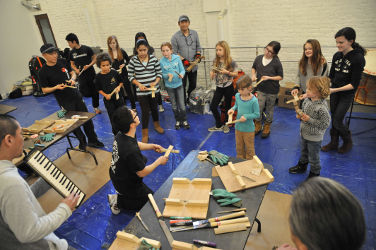 Kids rehearse on their take bera, or musical sticks. Photo by Lee Wexler/Images for Innovation.
The show’s director, Mitsuo Tamura, explained that when kids play music, there is no right or wrong way, just as there is no right or wrong in music. Sometimes music is an emotion, sometimes it is a prayer or a yearning. The kids are considered collaborators. They are also a prism into the community. “Overcoming the Disaster: Gratitude from Japan to the World” is an expression of Japan’s bonds of friendship with the entire international community for its support during the 2011 Earthquake and Tsunami. The emphasis is on community, like with a capital “C.”
Kids rehearse on their take bera, or musical sticks. Photo by Lee Wexler/Images for Innovation.
The show’s director, Mitsuo Tamura, explained that when kids play music, there is no right or wrong way, just as there is no right or wrong in music. Sometimes music is an emotion, sometimes it is a prayer or a yearning. The kids are considered collaborators. They are also a prism into the community. “Overcoming the Disaster: Gratitude from Japan to the World” is an expression of Japan’s bonds of friendship with the entire international community for its support during the 2011 Earthquake and Tsunami. The emphasis is on community, like with a capital “C.”
Before now, the workshop has not been held in conjunction with the worldwide concert series, but it has been pioneered in workshops in Soweto, Congo and Prague. “You understand a community through its children,” said Tamura. “At other places where we did this, like Congo, it was hard to meet the community. There, it was was because of politics, there were barriers. Here it is different, of course. But in each case, we take the community by the hand through its children, and we will do it again here.”
The kids were students of East Village Dance Project.
- Projects Organized by JFNY